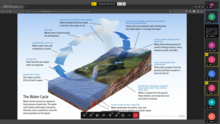
Back مدرسة افتراضية Arabic ভার্চুয়াল বিদ্যালয় Bengali/Bangla Εικονικό σχολείο Greek Escuela virtual Spanish آموزشگاه مجازی Persian Online iskola Hungarian Sekolah virtual ID 사이버 학교 Korean ਔਨਲਾਈਨ ਸਕੂਲ Punjabi Escola virtual Portuguese
This article has multiple issues. Please help improve it or discuss these issues on the talk page. (Learn how and when to remove these template messages)
|

An online school (virtual school, e-school, or cyber-school) teaches students entirely or primarily online or through the Internet. It has been defined as "education that uses one or more technologies to deliver instruction to students who are separated from the instructor and to support regular and substantive interaction between the students.[1] Online education exists all around the world and is used for all levels of education (K-12 High school/secondary school, college, or graduate school). This type of learning enables the individuals to earn transferable credits, take recognized examinations, and advance to the next level of education over the Internet.

Virtual education is most commonly used in high school and college. 30-year-old students or older tend to study online programs at higher rates.[2] This group represents 41% of the online education population, while 35.5% of students ages 24–29 and 24.5% of students ages 15–23 participate in virtual education.

Virtual education is becoming increasingly used worldwide. There are currently more than 4,700 colleges and universities that provide online courses to their students.[3] In 2015, more than 6 U.S. million students were taking at least one course online, this number grew by 3.9% from the previous year.[1] In 2021, more than 53% of postgraduate students were taking at least some classes online. The total number of online students in the U.S. was 7.5 million in 2024.[4]
Instructional models vary, ranging from distance learning types which provide study materials for independent self-paced study, to live, interactive classes where students communicate with a teacher in a class group lesson. Class sizes range widely from a small group of 6 pupils or students to hundreds in a virtual school.
The courses that are independent and self-paced are called asynchronous courses. Typically for this type of learning, the students are given the assignments and information and are expected to complete the assignments by the due date. This is done on their own time. There is no scheduled time when the class meets. Usually, the only interactions that take place are through discussion boards, blogs, and wikis.
On the other hand, synchronous online courses happen in real-time. The instructor and students all interact online at the same time. This is done either through text, video, or audio chat. Therefore, these lessons are socially constructed. In addition to the scheduled class time, there are usually additional assignments to complete. A key to keeping Kindergartners engaged in distance learning can be challenging. Individualizing lessons and giving mini breaks can help students stay engaged during short synchronous sessions. As an educator you have to find creative ways to keep children attention on the screen especially since they're in the comfort of their home with all their toys and all the other luxuries within the house they desire. It is hard to keep their attention in the classroom so virtual learning now becomes extremely harder.
Secondary school age students have to be extremely disciplined and focused in order to be successful in virtual learning. Just like being at an actual school, these pre-teens and teenagers have to make sure they are presentable/looking good before logging onto their classes and have to greet all of their friends and turn off their cell phones before the lesson begins because that will be a big distraction for them just as it would in the classroom. Some of the same problems that exist at school have the potential of existing at home with virtual school.
Hybrid, sometimes also called blended, courses are when students learn and interact both in-person and online. These classes meet in-person during the semester in addition to computer-based communication.[5]
During the COVID-19 pandemic, students around the world were forced to attend school online, although not all students had access to tablets or computers to attend. The number of online students decreased in 2022 and 2023, but remained well above pre-pandemic levels.[4]
- ^ a b c d Allen, Elaine (May 2017). "Distance Education Enrollment Report 2017" (PDF). Digital Learning Compass.
- ^ "Demographics of an Online Learner | Walden University". www.waldenu.edu. Retrieved 2024-04-19.
- ^ Friedman, Jordan (January 11, 2018). "Studey: More Students are Enrolling in Online Courses". U.S News.
- ^ a b "By The Numbers: The Rise Of Online Learning In The U.S. – Forbes Advisor". www.forbes.com. Retrieved 2024-04-19.
- ^ D., Potts Zachary. "Types of Online Learning". www.fordham.edu. Retrieved 2018-10-25.